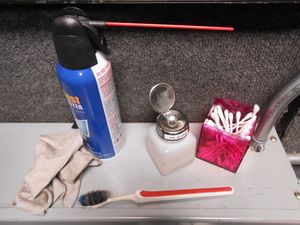| Welcome to Sprocket School! This project is maintained by volunteer editors. Learn more about how this works. |
Cleaning: Difference between revisions
Jump to navigation
Jump to search
No edit summary |
No edit summary |
||
| Line 27: | Line 27: | ||
* [http://www.nfsa.gov.au/preservation/handbook/conservation-treatments/particle-transfer-rollers/ PTR Rollers]: Again, Only use them if they are very well maintained and clean and you know what you are doing. Dirty PTR rollers can do more damage than good. PTR rollers are very good at keeping a perfectly clean print dust free, but the benefits of running a very dirty print through PTR rollers are negligible at best. | * [http://www.nfsa.gov.au/preservation/handbook/conservation-treatments/particle-transfer-rollers/ PTR Rollers]: Again, Only use them if they are very well maintained and clean and you know what you are doing. Dirty PTR rollers can do more damage than good. PTR rollers are very good at keeping a perfectly clean print dust free, but the benefits of running a very dirty print through PTR rollers are negligible at best. | ||
[[File:Film-cleaning-card-markiv.jpg|center]] | [[File:Film-cleaning-card-markiv.jpg|350px|center]] | ||
[[Category:Film handling]] | [[Category:Film handling]] | ||
[[Category: Film damage]] | |||
Revision as of 12:55, 4 April 2017

Supplies
- lint free cotton gloves
- electronics grade alcohol, 99.9% (Menda makes excellent spill-proof dispensers
- lint free Q-tips
- Toothbrush (dip in alcohol, run the motor and use the brush to clean the sprockets as they turn)
- clean rags (lint free)
- canned air
- lens cleaner, lens tissue (optics grade only! Do not use kimwipes on optical glass)
- port glass cleaner (windex or ½ distilled water and ½ vinegar)
- paper towels
- razor blades
- binoculars or spotting scope (a must!)
- flashlight/headlamp
Basic Cleaning
- Projector: Deep clean before every show (if you’re running shows close together at least clean the gate and trap and wipe down the rollers). Deep cleaning is a great time to check for any stalled rollers or broken, worn sprocket teeth or burrs. Between reels wipe down the gate and trap and rollers. Pull the aperture plate out and clean it so dirt doesn’t accumulate there. A clean toothbrush can be used to clean the sprockets,gently press the toothbrush to the sprockets as the motor is running. Use the canned air last as it tends to blow the dirt deep into the projector.
- Lenses: Clean monthly. Use only optics grade lens cleaner and lens wipes (no Kimwipes!). Wipe very gently, using a circular motion. Use this time to check for any cracked or fogged lenses.
- Port glass: clean your port glass on a regular basis! (windex or ½ distilled water and ½ vinegar) -carefull with Windex, you have to rub to get rid of the streaks and that can damage the coating on your port glass. If you can see the action of the film reflected on the port glass IT’S TIME TO CLEAN IT.
- General booth cleaning: Have a shop vacuum, keep surfaces and floors free of dust and debris.
Cleaning film
- Projectionists handling archival prints should NOT be cleaning the prints. Poorly maintained or improperly used cleaning equipment and supplies can do a tremendous amount of damage, so it's best not to do it. Cleaning equipment is really designed to clean prints that are run for an extended length of time at a venue, and chances are you're only running that archival print a few times.
- Solvents etc.
- Ultrasonic cleaners
- PTR Rollers: Again, Only use them if they are very well maintained and clean and you know what you are doing. Dirty PTR rollers can do more damage than good. PTR rollers are very good at keeping a perfectly clean print dust free, but the benefits of running a very dirty print through PTR rollers are negligible at best.
